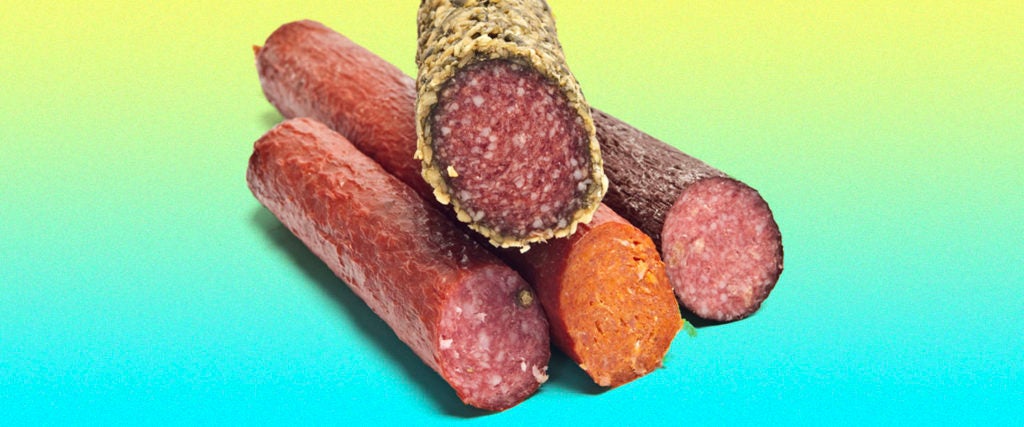If you love wieners and warm weather, a summer sausage may sound like quite the delight. Not that kind of sausage, silly — summer sausage is a special type of cured meat that’s great for munching on.
What is summer sausage?
“Summer sausage is literally just sausage that doesn’t need to be refrigerated,” says Jess Pryles, multi-platform meat influencer and author of Hardcore Carnivore: Cook Meat Like You Mean It. “It’s most definitely cured and usually fermented.”
Cured? Fermented? What does that mean?
Curing salts, which are typically a mixture of table salt and the preservative sodium nitrite, are used to “cure” summer sausages, which means they keep the meat from spoiling. Nitrite directly prevents the growth of bacteria, while salt draws water away from potentially nasty microorganisms, slowing down their growth. In fact, summer sausages are known to be especially dry, so don’t expect to be sprayed by meat juices as you bite into one.
Fermentation, meanwhile, involves introducing certain “good” bacteria into the meat, which converts some of the nutrients into carbon dioxide and alcohol (though, the amounts are really, really small — not enough to get you feeling right). Not only does this help prevent spoilage, since the added alcohol isn’t good for “bad” bacterial growth, but it also enhances the flavors.
How long does it last?
Unopened, it should stay good for a few weeks in a cold, dry environment, like your pantry, but it can last for months in the refrigerator or freezer.
What does it taste like?
That depends. Summer sausages can be made of all sorts of ingredients — pork, beef, venison, chicken, turkey, lamb, black pepper, red pepper, mustard, garlic, nutmeg, coriander, cheese or any combination. It’s similar to salami in terms of diversity (in fact, salamis could be categorized as summer sausages, although they’re typically dryer, and therefore tend to have an even longer shelf-life).
Is summer sausage healthy?
It’s not exactly healthy, because it’s mostly just meat and lots of salt, both of which are known to damage your heart if consumed in large enough amounts. It should deliver a nice dose of protein, though.
It’s also worth noting that while summer sausages usually utilize sodium nitrite, an ingredient that’s been associated with cancer in large enough amounts, Pryles says that the USDA “strictly controls the percentages of curing agents used” to prevent this from being a real concern.
Why’s it called a “summer” sausage?
Nobody’s entirely sure, but we have a good-sounding theory: Summer sausages originated in Germany, and back in the day, the winter months kept meats cold, which prevented them from going bad. Once the Germans figured out that curing could keep sausages good during the hot summer months, too — when food normally spoiled quickly — they decided to call cured sausages “summer” sausages. That’s the story, at least.
What’s the best way to eat summer sausages?
Because they’re already cured (and usually smoked, too), you don’t need to cook summer sausages — you can just bite right into them, like a stick of pepperoni. As such, they’re best served on a charcuterie board, accompanied by cheese and crackers.
Can I see your summer sausage?
If you’re nice.

